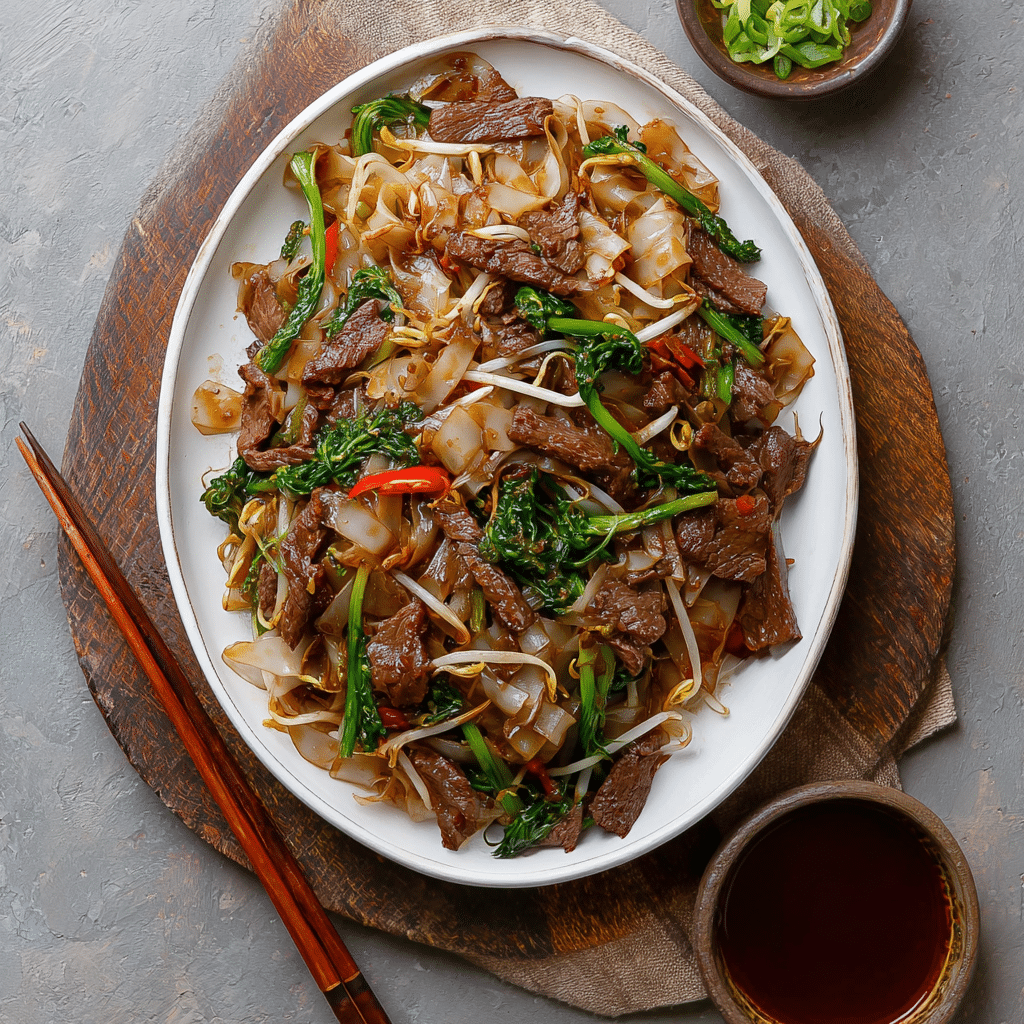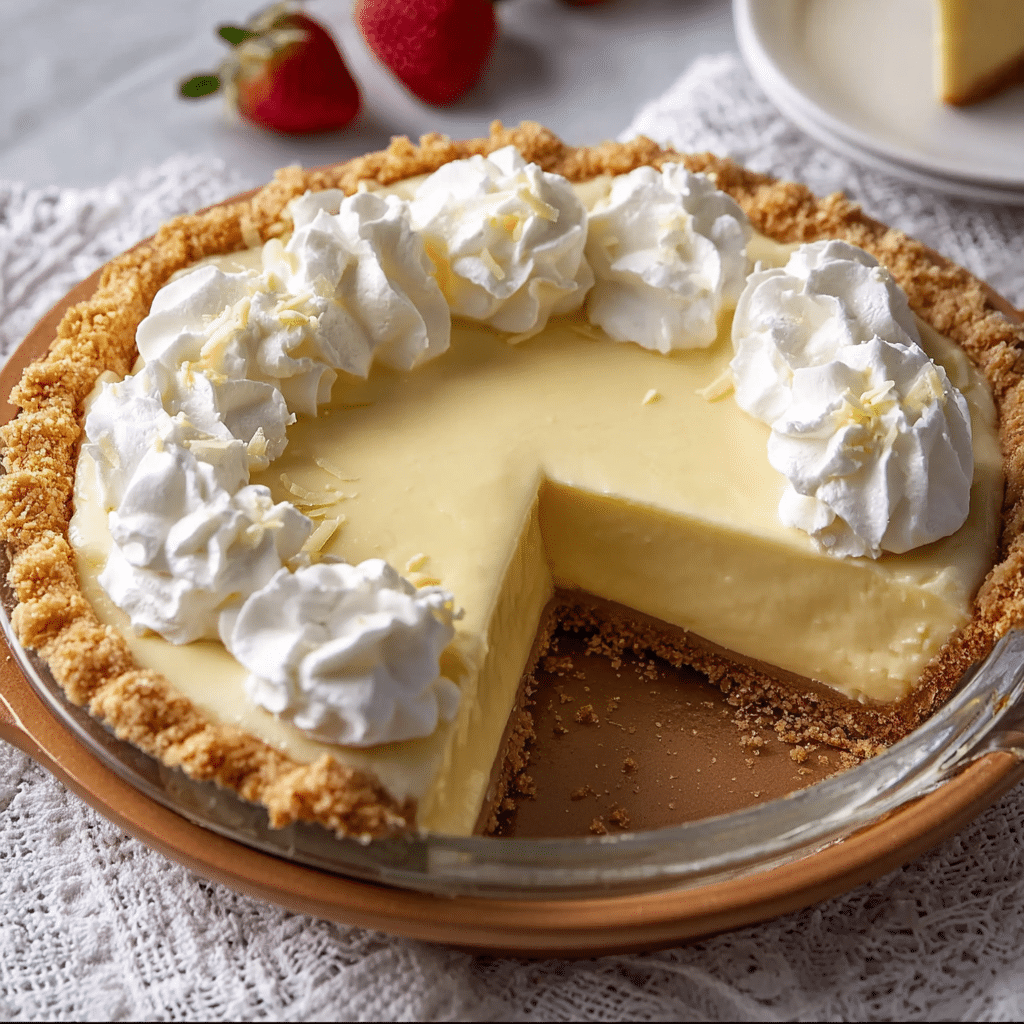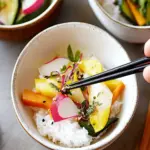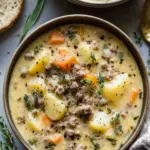Savor the bold flavors of this Vietnamese Beef Flat Rice Noodles dish—also known as Hu Tieu Ap Chao—a childhood favorite turned comfort food classic. With its chewy wide rice noodles, tender marinated beef, crisp-tender Chinese broccoli, and a rich oyster-soy glaze, every bite transports you straight to the bustling streets of Southern Vietnam.
This recipe is quick and irresistible for any night of the week: ready in just 45 minutes, you’ll be serving up restaurant-quality wok-charred noodles that balance savory depth, fresh greens, and satisfying texture. It’s timely, straightforward, and deeply comforting—perfect for family dinners or weekend indulgence.
Full Recipe
Ingredients:
-
2½ Tbsp oyster sauce
-
2 Tbsp soy sauce (low‑sodium)
-
1 Tbsp dark soy sauce
-
2 tsp granulated sugar
-
½ tsp black pepper
-
1 tsp Sriracha (optional)
-
½ lb thinly sliced beef (skirt/flank/ribeye)
-
¼ tsp baking soda
-
½ tsp garlic powder
-
¼ onion, thinly sliced (~⅔ cup)
-
4–5 stems Chinese broccoli (gai lan), cut into 1″ pieces
-
1 lb wide rice noodles, separated
-
1 cup bean sprouts
-
3–4 green onions, whites thin‑sliced, darks cut 1″
-
Cooking oil (avocado or neutral)
-
Salt, to taste
Directions:
-
Whisk oyster sauce, soy, dark soy, sugar, pepper, and Sriracha in small bowl.
-
In separate bowl, toss beef with baking soda, garlic powder, and 1½ Tbsp sauce; let marinate 15–20 min.
-
Heat 1 Tbsp oil in wok/skillet on high; sear beef ~1–2 min until browned but still pink. Remove and set aside.
-
Clean pan, add another Tbsp oil; sauté onion and gai lan with pinch of salt ~1–2 min until charred and vibrant.
-
Add another Tbsp oil plus noodles and half the sauce; gently toss 1–2 min until noodles soften.
-
Stir in bean sprouts, green onion greens, and remaining sauce; cook another 1–2 min.
-
Return beef, toss off heat; adjust seasoning, garnish with onion whites; serve hot.
Prep Time: 30 minutes | Cooking Time: 15 minutes | Total Time: 45 minutes
Kcal: 605 kcal | Servings: 4
The History and Origin of Hu Tieu Ap Chao
Hu Tieu Ap Chao is a beloved Vietnamese noodle dish that showcases the vibrant and diverse culinary culture of southern Vietnam. “Hu Tieu” typically refers to a noodle dish using thin, slightly chewy rice noodles, and “Ap Chao” indicates a pan-fried or stir-fried technique that crisps the noodles lightly for added texture and flavor. Unlike pho or bun, Hu Tieu has Chinese-Chaozhou roots, which explains the Chinese cooking influence in this dish—especially the sauce and stir-fry technique. Over generations, Vietnamese families have added their own ingredients and flavor touches, making it uniquely theirs while retaining the foundational Chinese elements.
This fusion is part of what makes Hu Tieu Ap Chao so special: it marries savory soy-based sauces with fresh Vietnamese herbs, greens, and proteins. It’s a dish that carries both cultural and nostalgic significance, often found in both home kitchens and bustling street food stalls. In fact, it’s most commonly eaten in southern regions like Saigon (Ho Chi Minh City), where you’ll find it on the menu at many casual eateries and food carts, especially in the evening.
Flavor Profile and Texture Experience
What makes Hu Tieu Ap Chao stand out is its complex harmony of textures and flavors. The rice noodles are wide and flat—somewhat similar to Chinese chow fun—offering a chewy, slightly springy texture. Pan-frying these noodles until they have lightly crisped edges adds a delicious contrast between soft and crisp. This dish is not soupy or brothy, like many Vietnamese noodle dishes, but instead uses a savory, reduced sauce to coat the ingredients with a glossy, flavorful glaze.
The sauce base includes a mixture of oyster sauce, light soy sauce, dark soy sauce, and sometimes a dash of Sriracha for heat. It’s salty, slightly sweet, and umami-rich. The beef, thinly sliced and marinated with garlic and seasoning, becomes incredibly tender thanks to the inclusion of baking soda—a common method in Asian cooking to break down muscle fibers. Chinese broccoli (gai lan) brings a crisp bite and subtle bitterness, while bean sprouts and green onions add freshness and lightness to balance the umami-dense flavors.
Cultural Significance and Eating Traditions
Hu Tieu Ap Chao is often considered a special treat or a family-favorite comfort dish, especially for dinner. In Vietnamese households, it may not be as commonly cooked as pho or bun bo hue, but it holds a nostalgic place in the hearts of many—particularly those who grew up in the south. The dish is also representative of Vietnamese adaptability; it uses ingredients that are locally available while maintaining the techniques and sauces inherited from Chinese immigrant traditions.
This dish is typically served hot from the wok and eaten immediately, ensuring the noodles retain their crispy edge and the vegetables stay vibrant and lightly cooked. It’s also a dish that invites customization—many households might add shrimp, squid, or chicken instead of beef, or even top it with a fried egg or extra chili for added richness.
Variations and Modern Twists
Though the classic version includes beef and Chinese broccoli, modern takes on Hu Tieu Ap Chao can be found in Vietnamese restaurants around the world. Chefs and home cooks alike experiment by using tofu or seitan for a vegetarian spin, while others might add mushrooms like shiitake or enoki to boost the umami factor. Some versions even include seafood like shrimp or squid for a more luxurious experience.
In Western kitchens, people have started replacing Chinese broccoli with broccolini or regular broccoli, depending on availability. Likewise, the flat rice noodles used in Hu Tieu may be swapped with other wide noodles like pad see ew or even fettuccine in a pinch—though traditionalists would argue the noodle texture is vital to the authenticity of the dish.
Another interesting development is the move toward gluten-free and low-sodium variations. With more health-conscious cooks adapting their family recipes, it’s possible to make this dish both diet-friendly and deeply flavorful with the right sauces and seasonings.
Why Hu Tieu Ap Chao is a Perfect Weeknight Meal
Despite its rich flavors and textures, Hu Tieu Ap Chao is surprisingly quick to make. It typically takes under an hour from prep to plate, making it ideal for busy weeknights. Most of the effort lies in the prep work—slicing the beef thin, chopping the veggies, and soaking or separating the noodles. Once the wok is hot, the stir-frying process takes mere minutes.
Another reason it works so well for weeknight cooking is its one-pan nature. Everything is cooked in stages in the same wok or large skillet, making cleanup much easier. You can prepare the noodles ahead of time or even use leftover beef from a previous meal to reduce cooking time.
It’s also a complete meal on its own. You’ve got your carbs, protein, vegetables, and a flavorful sauce all in one bowl—no side dishes needed unless you want to round it out with a light soup or some fresh fruit for dessert.
Tips for Making the Best Hu Tieu Ap Chao at Home
To truly capture the spirit of this dish, a few key tips can elevate your results:
-
Use a wok or a heavy-bottomed skillet: High heat and surface area are crucial for that wok hei (the smoky, charred flavor), which gives the dish its distinct taste.
-
Don’t overcrowd the pan: Cook the ingredients in batches if necessary. Too many ingredients at once will steam them rather than stir-fry them.
-
Separate the noodles carefully: If your noodles are refrigerated or clumped, gently separate them with your hands or soak them in warm water before stir-frying.
-
Marinate the beef properly: A quick 15–20 minute marinade goes a long way. The baking soda helps tenderize, but don’t overdo it or it can alter the taste.
-
Adjust to your spice tolerance: The traditional version isn’t overly spicy, but you can easily kick it up a notch with extra Sriracha, Thai chilis, or chili oil.
Pairing Suggestions and How to Serve It
Hu Tieu Ap Chao is hearty enough to serve on its own, but if you’re hosting or want to build a meal around it, consider pairing it with light, refreshing sides. A Vietnamese cucumber salad with rice vinegar and chili can contrast nicely with the savory noodles. Pickled vegetables or do chua (pickled carrot and daikon) are also excellent complements.
For beverages, iced jasmine tea or a cold Vietnamese coffee with condensed milk (ca phe sua da) adds a nice final touch. If you’re enjoying this at lunch, a lighter green tea or sparkling water with lime is also refreshing.
Presentation-wise, serve Hu Tieu Ap Chao in wide bowls or plates to allow space for the noodles and toppings. Garnish with extra green onion and a squeeze of lime, if desired. Some people also like to serve it with a side of hoisin sauce, soy sauce, or even fish sauce for personal dipping.
Conclusion: A Taste of Home and Heritage
Hu Tieu Ap Chao is more than just a noodle dish—it’s a delicious celebration of Vietnamese culinary tradition and cross-cultural influence. From its Chinese-Teochew origins to its modern Vietnamese adaptations, this meal represents the balance of flavor, texture, and comfort that defines much of Southeast Asian cooking. Whether you’re exploring Vietnamese cuisine for the first time or reconnecting with a childhood favorite, Hu Tieu Ap Chao delivers a satisfying experience in every bite.
It’s an incredibly versatile dish that can be adjusted to suit your taste or dietary needs, and it’s quick enough to become a regular in your dinner rotation. With its chewy noodles, tender beef, crisp vegetables, and savory sauce, Hu Tieu Ap Chao proves that great flavor doesn’t require complicated techniques—just good ingredients, a hot pan, and a little cultural know-how.








